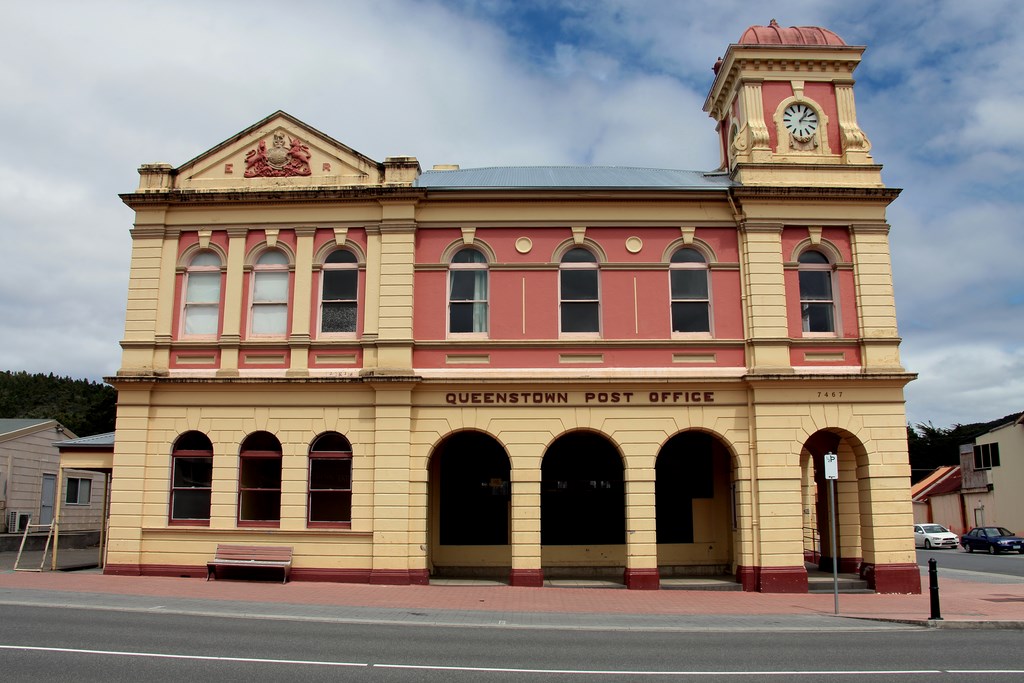QUEENSTOWN POST OFFICE
Queenstown (2 631 habitants en 2016) est une ville sur le versant ouest du mont Owen dans l'ouest de la Tasmanie en Australie à 248 km de Hobart.
---------------------------------------
Queenstown is a town in the West Coast region of the island of Tasmania in Australia. It is in a valley on the western slopes of Mount Owen on the West Coast Range. At the 2016 census, Queenstown had a population of 2,631 people.
History
Queenstown's history has long been tied to the mining industry. This mountainous area was first explored in 1862. It was long after that when alluvial gold was discovered at Mount Lyell, prompting the formation of the Mount Lyell Gold Mining Company in 1881. In 1892, the mine began searching for copper. The final name of the Mount Lyell company was the Mount Lyell Mining and Railway Company. Queenstown Post Office opened on 21 November 1896. A Queenstown South office opened in 1949 and closed in 1973. In the 1900s, Queenstown was the centre of the Mount Lyell mining district and had numerous smelting works, brick-works, and sawmills. The area at the time was finely wooded. The population in 1900 was 5051; the district, 10,451. The town was the base of the Queenstown council up until amalgamation with other west coast councils in the 1990s. The town in its heyday had a collection of hotels, churches and schools that have all significantly reduced since the demise of the Mount Lyell company. The town was the base of the Organisation for Tasmanian Development started in 1982. There was a brief boom in prosperity in the 1980s, with the building of several nearby dams by the Hydro. The Darwin and Crotty dams that comprise Lake Burbury (a popular fishing and recreation venue) were built during this period. These followed the cancellation of the Gordon-below-Franklin Dam in 1983 after strong campaigning by environmentalists in the 'No Dams' campaign.
Historiquement, Queenstown a été une ville minière. La région a été explorée pour la première fois en 1862, mais c'est longtemps après que de l'or alluvial a été découvert dans la région du mont Lyell, aboutissant à la création de la Mount Lyell Gold Mining Company en 1881. En 1892, la société a commencé l'exploitation du cuivre. Dans les années 1900, Queenstown était le centre du district minier de mont Lyell et abritait de nombreuses fonderies, briqueteries et scieries.
La région était, à l'époque, fortement boisée. La ville en 1900 avait 5051 habitants. La ville a été le siège du conseil de Queenstown jusqu'à la fusion avec d'autres conseils de la côte ouest dans les années 1990. La ville, à son apogée, avait nombre d'hôtels, d'églises et d'écoles qui ont considérablement réduit en nombre depuis la disparition de la société du Mount Lyell. Pendant une brève période, dans les années 1980, lors de la construction de barrages dans la région, la ville a connu un bref répit. Mais, depuis, les entreprises ont fermé et des installations ont été réduites. La reconstruction de la ligne de chemin de fer n'a pas sensiblement augmenté la prospérité de la ville quoique la reprise de l'exploitation minière dans la région y a contribué.
---------------------------------------
Queenstown is a town in the West Coast region of the island of Tasmania in Australia. It is in a valley on the western slopes of Mount Owen on the West Coast Range. At the 2016 census, Queenstown had a population of 2,631 people.
History
Queenstown's history has long been tied to the mining industry. This mountainous area was first explored in 1862. It was long after that when alluvial gold was discovered at Mount Lyell, prompting the formation of the Mount Lyell Gold Mining Company in 1881. In 1892, the mine began searching for copper. The final name of the Mount Lyell company was the Mount Lyell Mining and Railway Company. Queenstown Post Office opened on 21 November 1896. A Queenstown South office opened in 1949 and closed in 1973. In the 1900s, Queenstown was the centre of the Mount Lyell mining district and had numerous smelting works, brick-works, and sawmills. The area at the time was finely wooded. The population in 1900 was 5051; the district, 10,451. The town was the base of the Queenstown council up until amalgamation with other west coast councils in the 1990s. The town in its heyday had a collection of hotels, churches and schools that have all significantly reduced since the demise of the Mount Lyell company. The town was the base of the Organisation for Tasmanian Development started in 1982. There was a brief boom in prosperity in the 1980s, with the building of several nearby dams by the Hydro. The Darwin and Crotty dams that comprise Lake Burbury (a popular fishing and recreation venue) were built during this period. These followed the cancellation of the Gordon-below-Franklin Dam in 1983 after strong campaigning by environmentalists in the 'No Dams' campaign.
